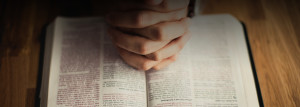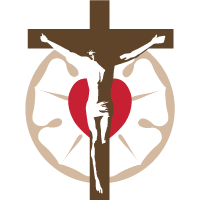by Rev. Dr. Mark Birkholz
 One of my seminary professors would often assign us to write prayers on our exams. It was not a worship class, or a class about prayer. He wisely recognized that if we truly understood our theology and knew how to apply it, then we would be able to take what we had learned and craft it into a prayer.
One of my seminary professors would often assign us to write prayers on our exams. It was not a worship class, or a class about prayer. He wisely recognized that if we truly understood our theology and knew how to apply it, then we would be able to take what we had learned and craft it into a prayer.
Theology will always lead to prayer. We listen to God and then echo His words back to Him in prayer. If you want to know what someone believes, listen to the way that they pray.
Luther wrote many prayers throughout his career. You may be familiar with his morning and evening prayers and his mealtime prayers in the Small Catechism.
When Luther revised and translated the liturgy from Latin to German, he often corrected the prayers or wrote new ones. One particularly noteworthy addition is the “Flood Prayer” which he added to the baptismal service.
Luther first translated the Baptismal Rite from Latin to German in 1523. He also pared down the rite, getting rid of many of the extra rituals, such as the blessing of the baptismal font. In 1526 he revised it again, streamlining it further to keep the baptism from getting lost in the midst of all the other traditions.
This revision became known as the “Baptismal Booklet” (Taufbuchlein) and was added to the Small Catechism, along with a similar “Marriage Booklet” (Traubuchlein) in 1529. These booklets were even included in some of the early drafts of the 1580 Book of Concord, before being dropped from the final, official copies.
There were many things that Luther removed from the Baptismal Rite, but he made one major addition: the “Flood Prayer.” In his introduction to the Baptismal Booklet, Luther emphasized that the prayers should be prayed slowly and clearly, so that the parents and sponsors could pray along silently in their heart.
The Flood Prayer was not included in The Lutheran Church—Missouri Synod’s hymnals for most of our history. But with the Lutheran Service Book (LSB), we now have the Flood Prayer back in our liturgy. This is the version included in the LSB (pp. 268-69):
Almighty and eternal God, according to Your strict judgment You condemned the unbelieving world through the flood, yet according to Your great mercy You preserved believing Noah and his family, eight souls in all. You drowned hard-hearted Pharaoh and all his host in the Red Sea, yet led Your people Israel through the water on dry ground, prefiguring this washing of Your Holy Baptism. Through the Baptism in the Jordan of Your beloved Son, our Lord Jesus Christ, You sanctified and instituted all waters to be a blessed flood, and a lavish washing away of sin. We pray that You would behold (name) according to Your boundless mercy and bless him with true faith by the Holy Spirit that through this saving flood all sin in him which has been inherited from Adam and which he himself has committed since would be drowned and die. Grant that he be kept safe and secure in the holy ark of the Christian Church, being separated from the multitude of unbelievers and serving Your name at all times with a fervent spirit and a joyful hope, so that, with all believers in Your promise, he would be declared worthy of eternal life, through Jesus Christ, our Lord.
If you want to know what baptism was all about for Luther, it’s right here in the Flood Prayer.
Here are three things that Luther’s Flood Prayer teaches us about Holy Baptism:
First, Holy Baptism drowns sin. Just as the flood drowned the evil and violent people in Noah’s day, and Pharaoh and his army were drowned in the Red Sea, so all sin in you is drowned and put to death. This includes both the original sin you inherit from Adam along with all the sins that you have ever committed. This drowning is not something that happens only at your baptism, but every time you confess your sins you are drowning them again. Luther says in the Small Catechism, “What does such baptizing with water indicate? It indicates that that Old Adam in us should by daily contrition and repentance be drowned and die, with all sins and evil desires…”
Second, Holy Baptism saves you. Noah and his family had a new life after the flood. The Israelites were set free from death and slavery in Egypt through the Red Sea. You have a new life in Holy Baptism. This is a pure gift of God because of His grace and mercy. In Holy Baptism you receive the gift of the Holy Spirit, who creates faith for you to trust in God and His gifts. The Holy Spirit will also keep you safe in the church until our Lord returns, just as He kept Noah and His family safe in the ark.
Third, Baptism leads to a life of service and praise. Luther prays that the one being baptized would serve God “all times with a fervent spirit and a joyful hope.” In baptism you are made a member of God’s holy priesthood and called to a life of service to Him. The sacrifices you offer are not the blood of sacrificial animals but the sacrifice of praise to God and acts of love towards your neighbor. This is the life to which you are called through your baptism.
That’s just the tip of the iceberg. There’s much more about baptism here in this prayer to meditate on throughout our life. In fact, you don’t have to just pray this prayer at baptisms. You can continue to pray this prayer for yourself as you give thanks for your baptism and pray that God keep you in true faith through His Holy Spirit, and you can use this prayer to pray for all of God’s baptized people.
The Rev. Dr. Mark Birkholz is pastor of Faith Evangelical Lutheran Church, Oak Lawn, IL.
